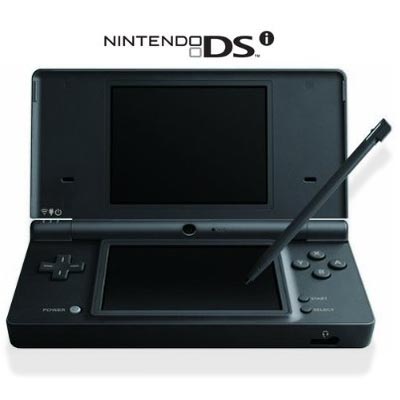
What’s with those clover-leaf speaker grilles?
The PSP is a fickle creature. It attempts to be an HD-like gaming device with stellar visuals and full console controls, yet doesn’t quite deliver on the portable ideology that a handheld game can’t be exactly like a console version. The latest version of the PSP tries to take this concept even more portable, notably with its “Go” moniker, and while it certainly does its job of getting smaller, Sony took it too far. Way too far. The buttons are tiny (granted, I have large hands), and it just isn’t a nice looking unit.
The unit is actually very nice; the slider is sturdy and doesn’t feel sticky at all. It is speedy, the 16GB of internal memory is a welcome addition, and the lack of UMD drive is a welcome subtraction. The screen portion has been carefully designed to not be so heavy that the unit doesn’t sit flat on a table when the slider is open. Clever and interesting designing on Sony’s part. Another interesting touch is the calendar and clock that is displayed when the slider is closed; oversized and functional, it would make a great desk clock, if only the unit came with a cradle.
When I got the box home, I noticed a familiar WiFi symbol on the side of the box. Barely out of eyesight, I pulled it closer wondering whether it was 802.11g or n. As it got closer, my heart nearly stopped when I saw it say b. Yes, b. As in, the defacto standard from the late 90s. Are you kidding me? You put out a device in 2009 with a feature that is supposed to have online multiplayer gaming and access PlayStation 3s remotely and you expect 802.11b to handle the bandwidth? Seriously Sony, for $200, you could’ve splurged on the extra $3.42 difference it would have cost to put in a g chip.
When the PSP-1000 came out, the screen was a revolution for handheld technology; bright, dense pixels, and an incredible quality build was evident whether you watched movies, played games, or cycled through photos. This screen seems merely evolutionary, and sadly, in reverse. It feels like they tried to squish and squash the resolution of the larger PSP screen into this one which is a few fractions of an inch smaller. Icons look slightly disjointed and blurry to me; a result of what was supposed to be some clever anti-aliasing that likely wasn’t executed as cleverly as planned. You’re probably also wondering about how the screen smudges. Let’s just say it doesn’t have an oleophobic coating.
I mentioned the gracious 16GB of internal memory, but only 14GB is available. I understand that there are BIOS settings and an operating system that take up space, but why does it take up two full gigabytes? What is on this device for OS that takes up so much data? In the long run, sure, this won’t matter, but if Sony has such inefficiencies in its OS, it just makes me wonder what other inconsistencies there are in the system and how much better it could be without them. At the end of the day, 14GB is still pretty sweet and a welcome addition to the family. The unit also packs an M2 slot for expansion of another 32GB on top of the internal memory. That’s quite a few (legally) downloaded games.
On to the superficial: colour. I chose to pick up the “Pearl White” unit because I owned a Black PSP-1000 back in the day. What a mistake. The outer plastic has what look like embedded sparkles in its surface, while the underlying plastic around the controls mires of sterile hospital plastic. We all know that simple white can be sexy, but Sony ignored anything to do with that mantra. Heed my warning and buy the black one. If enough people boycott the white unit, maybe Sony will never make it again. Ever again.
Lastly, something that I loved about the original PSP was the way the L and R buttons were so elegantly and invisibly integrated into the system. Talk about another reverse evolutionary step for Sony; the shoulder buttons on the go are loose and noisy, and get lost behind the screen. They do serve to scroll through the months in the calendar when the slider is closed, but let’s be honest, that certainly isn’t making this worth it.
I want to end on something positive but feel like I would be lying to you. Okay, fine, the unit is certainly solid, probably even more than it needs to be, and the internal memory is welcome, not to mention how slim the unit is, but let’s be honest, there simply isn’t enough here to warrant a purchase, especially if you already own an original PSP. Sony has actually issued a statement that they expect the release of the PSPgo to induce sales of their older units, not because they would be reduced in price, but because people wouldn’t see the need to pay more for the smaller device.
Read on to see my bottom line….
My bottom line? Slap a touchscreen on this, up the size of the buttons, throw in another analog stick and increase the quality of the screen, and you will have a sweet gaming device. Without those things, the PSPgo is just another reason to get a Nintendo DS.

To those wondering, Eggplante! actually started out writing about the gaming industry, so every once in a while, we like to keep things fresh and flowing from that side of the brain! Aren’t you tired of the JoBros. anyways? Now we can talk Mario Bros. instead!
